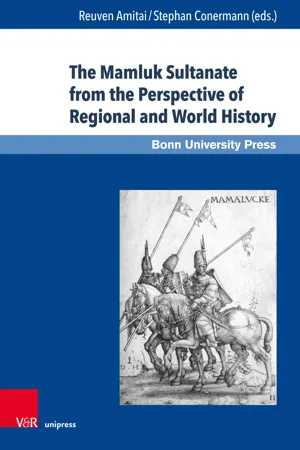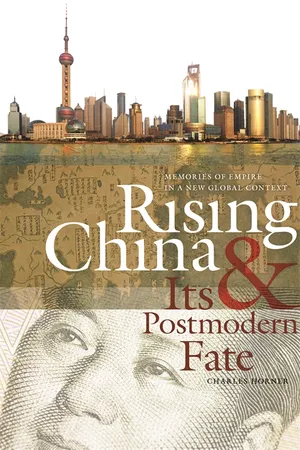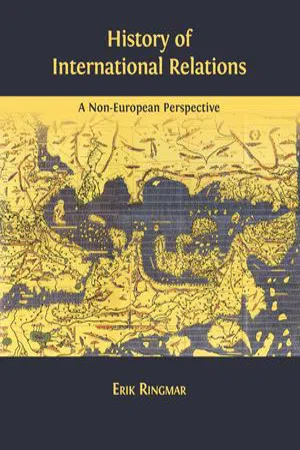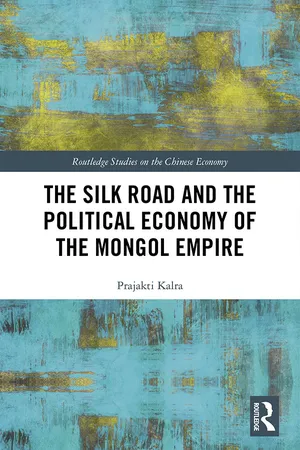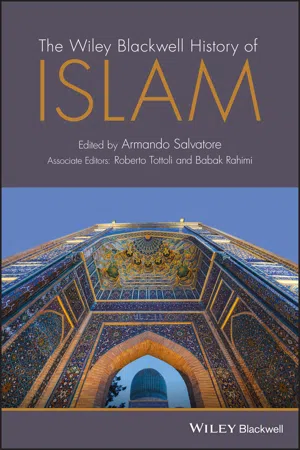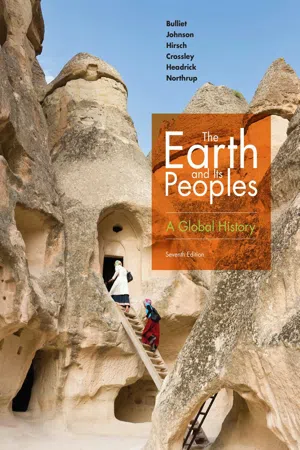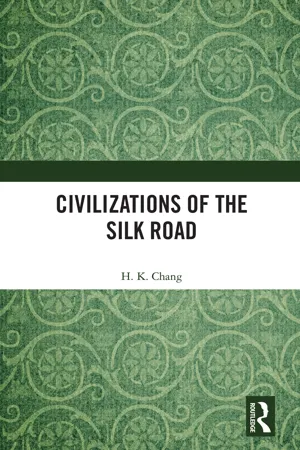History
Pax Mongolica
Pax Mongolica refers to the period of relative peace and stability across Eurasia during the height of the Mongol Empire in the 13th and 14th centuries. It facilitated increased trade, cultural exchange, and communication along the Silk Road, as well as the spread of ideas and technologies. The Mongol rule brought about a level of interconnectedness and prosperity across diverse regions.
Written by Perlego with AI-assistance
Related key terms
1 of 5
10 Key excerpts on "Pax Mongolica"
- Li Tang(Author)
- 2014(Publication Date)
- Harrassowitz Verlag(Publisher)
From antiquity (2 nd century B.C.) to the Mongol period (13 th century), the Silk Road underwent bloom and withering, war and peace, and conflicts between the nomadic Steppe and the sedentary world. In the 13 th century, the Mongol nomads conquered all the area of Eurasia and built their whole empire on horseback. The Pax Mongolica provided a period of peace in the region for over 100 years after the death of Chinggis Khan, during which trans-continental trade and all communication systems, e.g. postal service, were well administrated. The postal service network, which had already been established in China during the pre-Mongol period, was further extended during the reign of Ögödei Khan. The Pax Mongolica also enabled and secured human migrations, the flow of cultural exchanges, and the spread of world religions from the West to the East. The Mongol Khans also brought all peoples across the Eurasian continent under their rule, embracing the cultural and religious traditions of these peoples and inviting them to serve the Mongol court. Foreigners from Central Asia known in Chinese sources as “Semuren 色目人 ” began to settle down in China during the Yuan Dynasty. Among them were many Turkic-speaking peoples, Alans from the Caucasus, Armenians, Tibetans, Persians, Jews, Arabs, and some Europeans. 1.6. Medieval Travellers to the East The Pax Mongolica also opened a new perspective for Europe. After the fall of the Roman Empire in 476, 43 Europe experienced what some historians have called the “Dark Ages” (476–1000 A.D.) for a few centuries during which trade routes were falling into disuse. With the massive conquest and penetration of the Mongols into Eastern Europe, the threat to the Christian nations in Europe reached the front door of Europe. 42 For more on the Mongol heritage, see a relatively new publication edited by R EUVEN A MITAI -P REISS – D AVID O RRIN M ORGAN (eds.), The Mongol Empire and Its Legacy , Leiden: Brill 1999.- eBook - PDF
The Mongols and the Islamic World
From Conquest to Conversion
- Peter Jackson(Author)
- 2018(Publication Date)
- Yale University Press(Publisher)
The Pax : image, reality and the Silk Roads The Mongols brought under their rule not merely the margins but much of the heartland of the sedentary world of Asia; and it is now almost a common-place that this gave rise to two developments: a growth in transregional trade, through the removal of a multiplicity of tolls and other exactions and the elimination of competitive predators; and a more intense cross-cultural contact between distant regions of Asia (and between Asia and Europe) than in any previous era. The conditions created by the Mongol conquests have often been summed up in the phrase Pax Mongolica . But the proverbial security that enables the traveller, laden with riches, to move unmolested across enormous distances is the brainchild of the poet rather than the achievement of the prince. The Pax Mongolica repeatedly alluded to in liter-ature on the Mongols carries echoes of this fabled situation. It is borrowed, of course, from the much older concept of the Pax Romana – usually without due regard for the sardonic gloss on Roman exploits that Tacitus ascribes to a Caledonian chieftain: ‘they create a wilderness and call it peace’. 1 Chapter 7 will, it is hoped, have called into question the existence of a Pax during much of the period covered by this book. As Nicola Di Cosmo points out, the concept is less apposite still than its Roman counterpart, because after the early 1260s the Chinggisid empire ceased to be a unity. 2 Any discussion of the impetus given by the Mongols to transcontinental communication hinges in part on the previous history of the Silk Roads. 3 As Professor Valerie Hansen makes clear in her recent excellent study, this was not a road in any recognizable sense but ‘a stretch of shifting, unmarked paths across massive expanses of deserts and mountains’. Nor was silk the 8 Pax Mongolica AND A TRANSCONTINENTAL TRAFFIC 210 - eBook - PDF
The Mamluk Sultanate from the Perspective of Regional and World History
Economic, Social and Cultural Development in an Era of Increasing International Interaction and Competition
- Reuven Amitai, Stephan Conermann, Reuven Amitai, Stephan Conermann(Authors)
- 2019(Publication Date)
- V&R Unipress(Publisher)
© 2019, V&R unipress GmbH, Göttingen ISBN Print: 9783847104117 – ISBN E-Book: 9783847004110 Marie Favereau (University of Oxford) The Mamluk Sultanate and the Golden Horde. Tension and Interaction During the Mongol Peace “The Mongol Peace” is an old paradigm originally modeled on the notion of Pax Romana. 1 It refers to the post-conquest stability of the Mongol dominions and supposedly peaceful relationships between the descendants of Chinggis Khan. During the Mongol Peace a commercial boom transformed the human landscape in western Eurasia, connecting the Mediterranean Sea to India and China. The ways Mongols stimulated the exchanges resulted in a new form of long-distance trade. The agreements they established with the Mamluks, the Byzantines, the Italians, and others, led to the transformation of the trade networks. A new economic order emerged, which cannot be seen as the mere revival of the con- tinental silk roads of the ancient world. A major change was that it deeply connected for the first time Egypt and the Volga basin. The phenomenon of the Mongol Peace lasted roughly a century: from the 1260s, when the old Chinggisid empire split into four Khanates, to the late 1360s. At that time, the Ming have replaced the Mongols in China, Tibet and Mongolia; the Ilkhanate, once covering Iran, Azerbaijan, Iraq and Eastern Anatolia, has fallen apart. Only the Chagatay Horde in Central Asia and the Golden Horde in western Kazakhstan, Southern Siberia, Russia and Eastern Europe, resisted and adapted to the new geopolitical situation. From its inception, the descendants of Jöchi, the eldest son of Chinggis Khan, ruled over the Golden Horde. The Jöchids had their main winter camp in the lower Volga. For summer, they moved west towards the Don or south towards the Caucasus. - eBook - PDF
Rising China and Its Postmodern Fate
Memories of Empire in a New Global Context
- Charles Horner, Gary Bertsch, Howard Wiarda(Authors)
- 2010(Publication Date)
- University of Georgia Press(Publisher)
22 CHAPTER 2 THE YUAN DYNASTY AND THE Pax Mongolica “Today, thanks to God and in consequence of Him,” noted the great Per-sian historian Rashid al-Din (1247–1317) in the introduction to his magnum opus of 1308, the extremities of the inhabited earth are under the dominion of the house of Genghis Khan, and philosophers, astronomers, scholars, and histori-ans from North and South China, India, Kashmir, Tibet, the land of the Uighurs and the other Turkic tribes, the Arabs and the Franks, all belonging to different religions and sects, are united in large numbers in the service of majestic Heaven. And each one had manuscripts on the chronology, history and articles of faith of his people, and each has knowledge of some aspect of this. Wis-dom, which decorates the world, demands that there should be prepared from these chronicles and narratives an abridgement, but still an essentially complete work. . . . This book in its totality will be unprecedented—an as-semblage of all the branches of history. Yuan Dynasty and the Pax Mongolica 23 Al-Din’s book, Collected Chronicles , was for that time—indeed, for any time—an enormous undertaking, assembled by writers and researchers who, among them, commanded a wide array of languages—Chinese, Per-sian, Kashmiri, Uighur, Mongolian, Hebrew, Arabic, Tibetan, and Frank-ish—and an even wider range of special interests—agronomy, geography, science, medicine, mathematics, religion, philosophy, government, and genealogy. The work also relies on traditional oral history for accounts of steppe nomads. - eBook - PDF
- Erik Ringmar(Author)
- 2019(Publication Date)
- Open Book Publishers(Publisher)
Yet apart from their military superiority, they had nothing much to impart to the rest of the world. The Mongols made no technological breakthroughs, founded no religions, built no buildings, and they had not even mastered simple techniques such as weaving, pottery or bread-making. Rather, by conquering such a vast territory, and by unifying it under the same administration, they managed to connect parts of the world which had never previously been connected, or not connected as closely and efficiently. The results were profound and revolutionary. Throughout the land they controlled, the Mongols guaranteed the security of travelers and they encouraged trade by reducing taxes and facilitating travel. During the so-called Pax Mongolica , the “Mongol peace,” exchanges along the caravan routes of Central Asia became more intense than ever before. This was when Persian businessmen would go to China on regular visits and when a diplomatic envoy from a Mongol khan could visit Paris and take communion with the pope in Rome. © 2019 Erik Ringmar, CC BY 4.0 https://doi.org/10.11647/OBP.0074.05 HISTORY OF INTERNATIONAL RELATIONS 102 The Mongol Empire lasted only some 150 years. The political structure had already begun to crack by the middle of the thirteenth century and by the early fourteenth century it was disintegrating. In 1368, the Mongols lost control over their most prized possession — China. One important reason for the decline and fall of the Mongol empire was the perpetual infighting which took place among Genghis Khan’s descendants. By the middle of the thirteenth century, when his grandchildren were ready to take over the realm, the question of succession turned out to be impossible to settle. - Prajakti Kalra(Author)
- 2018(Publication Date)
- Routledge(Publisher)
Viewed especially in the context of the Crusades which were still going on in the thirteenth century, Mongol Eurasia offered itself up for a far more cosmopolitan and free geographical space than what either fol- lowed immediately after the Mongol century or even what is in place today. In summary, economic relations and commercial interests could dictate Mongol policies without being muddled by religious limitations. Mongol Eurasia was traversed by the Chinese, Indians, Central Asians, Iranians, Iraqis, Vene- tians, Genoese and other Europeans (including French and German artisans) rep- resenting a variety of faiths and religions. What is even more interesting is that many states that replaced the Mongols, Muslim (Amir Timur’s Central Asia, Safavids). Christian (Russia) and Chinese (Ming) all owe their rise to power and The place of religion 67 in some cases as in Timur even their legitimacy to Chinggis Khan and the pres- ence of a Mongol Eurasia. 84 Whether the Mongols were religious or not, or whether they became more religious as time went by, their main contribution was to create opportunities and conditions for trade across the Silk Road and across Eurasia to include a huge number of people and unprecendented quant- ities of goods and products, spurring a whole new system for future centuries. According to scholars like Abu-Lughod 85 and Jack Goody, 86 Mongol Eurasia was a precursor to modern day economic relations especially in the context of globalisation. The next chapter looks at the growth of cities as commercial hubs as a result of the institutional framework and religious policies of the Mongols which accelerated the reconstruction, revival and growth of a variety of cities across Mongol Eurasia. It considers the variety of ways in which the Mongols interacted with cities which were sources of economic prosperity, human capital, symbols of legitimacy and prestige and economic and political centres.- eBook - PDF
- Armando Salvatore(Author)
- 2018(Publication Date)
- Wiley-Blackwell(Publisher)
His powerful family played an important role during the reign of the successors of Hulegu, Abaqa (r. 1265– 1281) and Ahmad Tegüder (r. 1281–1284). The conflict that broke out after the conversion of this latter khan to Islam also led to the end of the Juwayni family. Shams al‐Din Muhammad and the famous chronicler ‘Ata Malik (1226–1283), belonging to the same family, died under Arghun Khan (r. 1284–1291), who imposed a strong anti‐Islamic course and was particularly harsh with the Persian Muslim elites (Aubin 1995). The period between the reign of Abaqa and that of Ghazan (r. 1295–1304), who completed the Ilkhanid conversion to Islam, is generally identified as a peaceful time, and to define it Western scholars have coined the term Pax Mongolica , with an Pax Mongolica and its Impact on Patterns of Governance 279 obvious allusion to the pax romana . Certainly from the commercial point of view, this period was extremely fruitful for the West. A series of political agreements between European rulers and the Mongols favored European interests, in particu-lar Italian travelers, who were allowed to cross the Ilkhanid and Yuan territories. The Genoese exploited these commercial opportunities in the Ilkhanid domains, particularly by establishing offices in Tabriz, which allowed them to reach the Far East without facing impossible obstacles on their itineraries. Not very different was the situation with the Venetians and other European traders, even though the Venetians were in constant conflict with the Genoese. The installation of various archbishoprics in present‐day Iran, Anatolia, and Central Asia was the occasion for a systematic attempt at evangelization (Golubovich 1906–1927). Nevertheless, the period coinciding with the first part of the Later Middle Period was not, strictly speaking, as peaceful as Pax Mongolica purports. - eBook - PDF
The Earth and Its Peoples
A Global History
- Richard Bulliet, Pamela Crossley, Daniel Headrick, Steven Hirsch(Authors)
- 2018(Publication Date)
- Cengage Learning EMEA(Publisher)
Due to electronic rights, some third party content may be suppressed from the eBook and/or eChapter(s). Editorial review has deemed that any suppressed content does not materially affect the overall learning experience. Cengage Learning reserves the right to remove additional content at any time if subsequent rights restrictions require it. 319 The tremendous extent of the Mongol Empire promoted the movement of people and ideas from one end of Eurasia to the other. Trade routes improved, markets expanded, and the demand for products grew. Trade on the Silk Road, which had declined with the fall of the Tang Empire (see Chapter 12), revived. Between 1218 and about 1350 in western Eurasia and down to 1368 in China, the Mongols focused on specific economic and strategic interests, usually permitting local cultures to survive and develop. In some regions, local reactions to Mongol domination sowed seeds of regional and ethnic identity that blossomed in the period of Mongol decline. Regions as widely separated as Russia, Iran, China, Korea, and Japan benefited from the Mongol stimulation of economic and cultural exchange and also found in their opposition to the Mongols new bases for political consolidation and affirmation of cul-tural difference. ● 13-1 The Rise of the Mongols, 1200–1260 What accounts for the magnitude and speed of the Mongol conquests? The Mongol Empire owed much of its success to the cultural institutions and political traditions of the Eurasian steppes (prairies) and deserts. The pastoral way of life known as nomadism gives rise to imperial expansion only occasionally, and historians disagree about what triggers these episodes. In the case of the Mongols, a precise assessment of the personal contributions of Chinggis Khan and his successors remains uncertain. Mongols A people of this name is mentioned as early as the records of the Tang Empire, living as nomads in northeastern Eurasia. - eBook - PDF
The Horde
How the Mongols Changed the World
- Marie Favereau(Author)
- 2021(Publication Date)
- Belknap Press(Publisher)
Thus did the begs become a power center of their own, with an agenda that was both historically unusual and yet legible within the universe of Mongol political theory and practice. When we dig into the story of the Pax Mongolica, we find how in- adequate that concept is. The Horde, and the Mongols in general, did not “settle in” to a golden age. Prosperity did not entail stability. Rather, it was the Horde’s plasticity that enabled its continuing success. Even as the regime grew wealthier, it became that much more politically frac- tious; internal tensions were not incompatible with economic success. 166 THE HORDE Ulus Jochi was a living, breathing entity, whose leaders constantly cali- brated their policies in order to achieve public and personal goals and thereby created new conditions that spawned further transformations. The Pax Mongolica story encourages us to see the Horde as a state that rose, peaked, and fell—an empire that gained all it could from its strengths, burned through its good fortune, and then failed to de- velop further in the face of a changing world. The truth is far more interesting. Peace in the Horde The Blue Horde, led by the descendants of Jochi’s eldest son Orda, was a key factor in the peace the Horde enjoyed in the final third of the thirteenth century. During this period, the Blue Horde grew in num- bers. A few thousand warriors and their families became ten thou- sand or more. In addition to Orda’s direct family, his keshig and horde gathered women and men of various origins, including Qonggirad, Merkit, Kereit, Arghun, Oyirad, Naiman, and Kinggut. The Kinggut was a large military group who descended from the original minggan: the unit of a thousand warriors Chinggis had given to Jochi, which Orda inherited. Also in Orda’s horde were the Jalayir warriors. Orda probably ac- quired the Jalayir during the Hungarian campaign of the early 1240s. These seasoned warriors comprised four minggan and obeyed a powerful Oyirad family. - eBook - ePub
- H. K. Chang(Author)
- 2023(Publication Date)
- Routledge(Publisher)
Eurasia Under Mongol RuleDOI: 10.4324/9781003369899-14There is a saying in academic circles today that real “world history” only began with the Mongol Empire (1206–1368).We have amply explored economic and cultural exchange between the eastern and western wings of Eurasia, as well as the migration of peoples, but these links and influences were indirect and often interrupted. Even the Battle of Talas, in which the Arab army ended the Tang Dynasty’s dominance and profoundly influenced the history of Central Asia, was essentially a random military encounter. It was the establishment of the Mongol Empire that initiated the establishment of concrete, practical ties— on the political level—between the two extremes of the Eurasian continent, and led to smooth and prosperous interactions.I have discussed the Ottoman Empire previously and will detail the Timurid Empire later. If we add the Ming, then we have identified the three great empires that co-starred during the 14th century—and all were closely associated with the Mongols. The Ming overthrew the Mongols and founded their own dynasty, while Timur was a Turkic-speaking emir of the Mongol ruling group. He emerged victorious from political infighting inside the Chagatai Khanate, and frequently interacted with the White Horde that was born of the division of the Kipchak Khanate of the Mongol group.During one of their Western Expeditions, the Mongols crushed the Seljuk Sultanate of Rûm, and this led to the division of its territory into many small states including the Ottoman principality. Meanwhile, the Russians in Eastern Europe were ruled by the Mongols for two centuries, and historically they perceived Ivan III’s victory in 1480 over the Mongol-Tatar forces as marking their liberation from the Mongol yoke. Therefore, even without querying whether globalization was initiated by the Mongols, the historical role of the Mongol Empire is a topic worthy of serious study.
Index pages curate the most relevant extracts from our library of academic textbooks. They’ve been created using an in-house natural language model (NLM), each adding context and meaning to key research topics.


